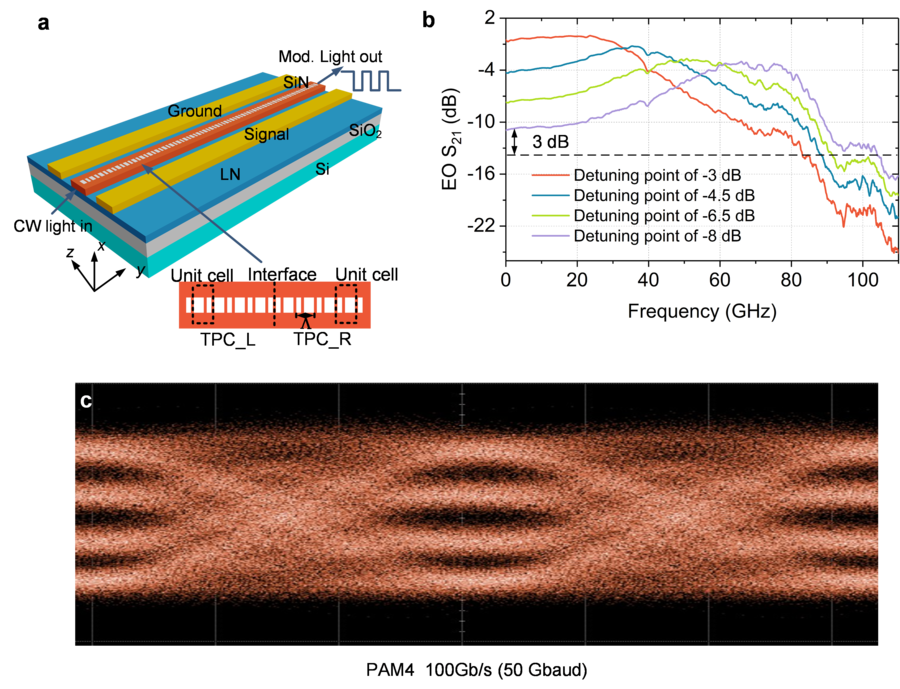High-speed electro-optic modulation in topological interface states of a one-dimensional lattice
KNOXVILLE, TN, October 19, 2023 /24-7PressRelease/ — Electro-optic modulators are key components in data communication and microwave photonics. Large modulation bandwidth, high energy efficiency, and compact device footprint are crucial metrics of a modulator. Towards these goals, Chinese scientists invented an ultracompact topological modulator for the miniaturization of electro-optic modulators. This topological modulator accelerates the response time of topological photonic devices from the microsecond order to the picosecond order and provides an essential foundation for the implementation of large-scale photonic integrated circuits.
Electro-optic modulators, which convert signals from the electrical to the optical domain, are at the heart of optical communications, terahertz wireless communications, microwave signal processing, and quantum technology. Next-generation electro-optic modulators require high-density integration, compact footprints, large bandwidths, and low power consumptions. They are challenging to achieve with established integrated Mach-Zehnder interferometer (MZI) or microring devices.
Attributing to the unique properties of topological photonics including tight optical confinement, robust transport of light, and immunity to defects, integrated lithium niobate (LN) waveguides with topological interface states can help address the challenges of next-generation electro-optic modulators. Topological phase transition has been utilized to demonstrate integrated photonic devices including nonlinear and quantum devices, but the response times of the topological devices were limited to the microsecond order. High-speed topological modulators have not yet been exploited.
In a recent paper published in Light Science & Applications, a team of scientists, led by Prof. Yikai Su and Prof. Yong Zhang from Shanghai Jiao Tong University and co-authors have developed an ultracompact, high-speed, large-bandwidth, and energy-efficient electro-optic modulator with a topological interface state in a 1D microstructure lattice on a silicon-nitride-loaded-lithium-niobate-on-insulator (SiN-LN) platform. The 1D topological cavity features a shorter length than the conventional 1D Bragg grating structures. Unlike the photonic crystal nanobeam cavity with multiple resonant modes, the topological cavity allows flexible control of the Q factor and mode volume while strictly maintaining single-mode operation and avoiding the mode number control. Experimental results show that the length of the high-speed electro-optic modulator is only 140 μm, with an ultralow power consumption of 5.4 fJ/bit and a large modulation bandwidth of 104 GHz.
The topological modulator is based on topological interface state, which is formed between two topological photonic crystals with distinct topological invariants and surface impedance in the 1D lattice based on the classic Su-Schrieffer-Heeger (SSH) model. To obtain a topological interface state at one photonic bandgap, the gap topological invariants on the left and right topological photonic crystals are required to ensure a difference of π. A method of crossing a topological transition point is used to change the sign of the topological invariant. The device exhibits excellent performance in terms of ultrasmall size, high speed, and energy efficiency. These scientists summarize the operational principle of their topological modulator:
“The interface state enables the first topological modulator with a compact size of only 1.6 x 140 μm2, which is the most compact thin film LN modulator with a bandwidth exceeding 20 GHz. Peaking enhancement in the electro-optic response of the topological cavity is utilized to break the photon-lifetime-limited bandwidth, resulting in a large bandwidth of 104 GHz.”
“Due to the small electro-optic modal volume and short electrode length, low radio frequency loss and small capacitance are achieved, yielding ultralow energy consumption of 5.4 fJ/bit.” They added.
“The demonstrated devices can generate 100 Gb/s non-return-to-zero (NRZ) and 100 Gb/s four-level pulse amplitude modulation (PAM4) signals. To the best of our knowledge, we have implemented the first high-speed topological electro-optic modulator using the topological interface state. The topological modulator shows great promise for applications of high-speed modulation in fully integrated LN photonics and promotes applications of topological devices in optical communications, microwave photonics, and quantum information processing.” The authors said.
References
DOI
10.1038/s41377-023-01251-x
Original Source URL
https://doi.org/10.1038/s41377-023-01251-x
Funding information
This work was supported in part by the Key Technologies Research and Development Program under Grant 2020YFB2206101 and the National Natural Science Foundation of China (NSFC) under Grant 62035016/61975115/61835008.
Contact
Yong Zhang
State Key Lab of Advanced Optical Communication Systems and Networks, Department of Electronic Engineering, Shanghai Jiao Tong University, Shanghai 200240, China, yongzhang@sjtu.edu.cn
About Light: Science & Applications
The Light: Science & Applications will primarily publish new research results in cutting-edge and emerging topics in optics and photonics, as well as covering traditional topics in optical engineering. The journal will publish original articles and reviews that are of high quality, high interest and far-reaching consequence.
Chuanlink Innovations, where revolutionary ideas meet their true potential. Our name, rooted in the essence of transmission and connection, reflects our commitment to fostering innovation and facilitating the journey of ideas from inception to realization.
Related Link:
http://chuanlink-innovations.com
—
For the original version of this press release, please visit 24-7PressRelease.com here





